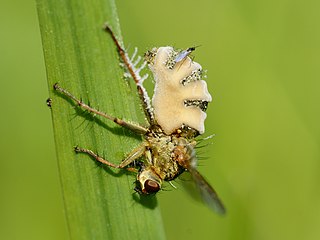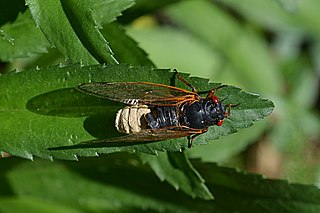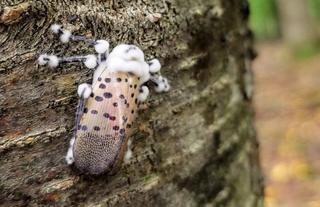
An entomopathogenic fungus is a fungus that can kill or seriously disable insects.

The Entomophthorales are an order of fungi that were previously classified in the class Zygomycetes. A new subdivision, Entomophthoromycotina, in 2007, was circumscribed for them.

Entomophthora is a fungal genus in the family Entomophthoraceae. Species in this genus are parasitic on flies and other two-winged insects. The genus was circumscribed by German physician Johann Baptist Georg Wolfgang Fresenius (1808-1866) in 1856.

Tipula is a very large insect genus in the fly family Tipulidae. The members of this genus are sometimes collectively called common crane flies. Tipula contains over 2,000 species located throughout the world.

Entomophthora muscae is a species of pathogenic fungus in the order Entomophthorales which causes a fatal disease in flies. It can cause epizootic outbreaks of disease in houseflies and has been investigated as a potential biological control agent.

Euxoa ochrogaster, the red-backed cutworm, is a moth of the family Noctuidae. It is found from Iceland and northern Europe, through the Baltic to the Amur region. In North America, it is found from Alaska to Newfoundland and Labrador, south into the northern part of the United States, south in Rocky Mountains to Arizona and New Mexico.

Entomophaga is a genus of entomopathogenic fungi in the Entomophthoraceae family and also the order Entomophthorales. This has been supported by molecular phylogenetic analysis.

Entomophthoromycota is a division of kingdom fungi. In 2007, it was placed at the taxonomic rank of subphylum in the most recent revision of the entire fungus kingdom. In 2012, it was raised to the rank of phylum as "Entomophthoromycota" in a scientific paper by Richard A. Humber 2012. Divided into three classes and six families, it contains over 250 species that are mostly arthropod pathogens or soil- and litter-borne saprobes.

Pandora is a genus of fungi within the order Entomophthorales of the Zygomycota. This has been supported by molecular phylogenetic analysis.
Zoophthora is a genus of fungi in the family Entomophthoraceae. Like other taxa in this family, Zoophthora species cause disease in insects and as such are considered entomopathogenic fungi.
Erynia is a genus of fungi within the family of Entomophthoraceae and order Entomophthorales of the Zygomycota. This has been supported by molecular phylogenetic analysis.

Arthrophaga myriapodina is a fungus in the Entomophthorales that parasitizes the millipedes Apheloria virginiensis corrugata, Boraria infesta, and Nannaria sp. Infected millipedes typically climb to an elevated spot before death.

Massospora is a genus of fungi in the Entomophthoraceae family, within the order Entomophthorales of the Zygomycota. This has been supported by molecular phylogenetic analysis.

Entomophthoraceae is a family of fungi in the order Entomophthorales. This has been supported by molecular phylogenetic analysis. Most species in the family are obligately entomopathogenic. There are two subfamilies, Erynioideae and Entomophthoroideae, which were proposed in 2005.
Strongwellsea is a genus of fungi within the order Entomophthorales of the Zygomycota. They are known to infect insects. Infected adult dipteran hosts develop a large hole in their abdomens, through which conidia (spores) are then actively discharged while the hosts are still alive.

Furia is a genus of fungi within the family of Entomophthoraceae of the Zygomycota. This has been supported by molecular phylogenetic analysis.

Batkoa is a genus of fungi within the family of Entomophthoraceae and order Entomophthorales of the Zygomycota. This has been supported by molecular phylogenetic analysis.
Eryniopsis is a genus of fungi within the family of Entomophthoraceae and order Entomophthorales of the Zygomycota. This has been supported by molecular phylogenetic analysis.
Meristacrum is a fungal genus in the monotypic family Meristacraceae, of the order Entomophthorales. They are parasites of soil invertebrates, they typically infect nematodes, and tardigrades.











